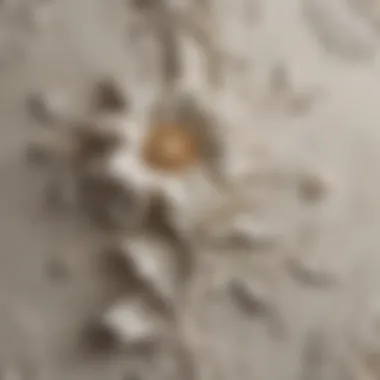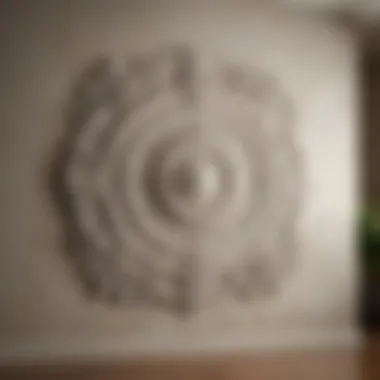Exploring Plaster Decorations: Techniques & Trends


Intro
Plaster decorations have long been a captivating element of architectural design. Their versatility allows for a unique blend of aesthetics and functionality. This article explores how plaster can transform wall surfaces, revealing diverse techniques, modern trends, and applications that resonate with homeowners, designers, and architecture enthusiasts.
Understanding the potential of plaster decorations is essential in the evolving landscape of interior design. As trends shift towards personalization and unique expressions of style, plaster becomes a preferred choice. From ornate traditional styles to sleek contemporary designs, plaster offers a canvas rich in possibilities.
Home Design Inspiration
Architectural Styles
Plaster decorations draw upon a range of architectural influences. These styles often reflect regional characteristics and historical contexts. Recognizing these influences can be beneficial in selecting plaster features that harmonize with a home’s overall design.
Traditional Styles: These designs are often elaborate, utilizing techniques like stucco, which has been popular in Mediterranean and Spanish architecture. Ornate cornices, ceiling medallions, and decorative friezes are commonly seen.
Modern Styles: Here, the emphasis shifts towards clean lines and minimalism. Smooth, flat finishes or geometric patterns are favored. Innovations such as 3D plaster panels create dynamic visuals without excessive ornamentation.
Innovative Decor Trends
In the realm of interior design, plaster decorations are not just about enhancement; they reflect current trends and innovative approaches.
- Textured Finishes: Increasingly, designers are incorporating rough textures to create depth. These surfaces can enhance light play in a room, boosting visual interest.
- Color Variations: While classic white plaster remains popular, the trend is moving towards colored finishes that complement modern palettes. Soft hues or bold contrasts can play a significant role in achieving desired moods.
- Sustainable Materials: The conversation around eco-friendly materials is transforming the plaster industry. Using non-toxic, sustainable plaster mixes resonates well with environmentally conscious consumers.
Applications of Plaster Decorations
The application of plaster techniques goes beyond basic wall finishes. Here are some targeted uses:
- Accent Walls: Creating a feature wall with textured or patterned plaster can act as an artistic focal point in living areas.
- Ceiling Treatments: Decorative plaster ceilings can inspire awe. Coffered or domed ceilings heighten the sense of space.
- Outdoor Spaces: Exterior plaster applications like stucco can be both decorative and durable, showcasing creativity in gardens or patios.
"Plaster decorations are more than just wall coverings; they are an art form that connects history, culture, and personal expression."
In summary, plaster decorations provide endless opportunities for artistic expression in modern architecture. By understanding a range of techniques, current trends, and applications, homeowners and designers alike can enrich spaces with a touch of elegance and innovation.
Prelims to Plaster Decorations
The world of plaster decorations for walls presents a unique intersection of art and functionality. This section lays the groundwork for understanding the fundamentals and importance of plaster as a medium. From its historical significance to modern applications, plaster decorations offer aesthetic enhancements that elevate the ambiance of interior spaces.
Plaster root itself stems from centuries of cultural practices. Its evolution reveals not only technical advancements but also changing design sensibilities over time. This article will explore different aspects of plaster decorations, focusing on practical techniques, current trends, and their functional benefits.
Definition and History
Plaster is a construction material made from a mixture of lime, gypsum, or cement with water. Once applied to walls, it hardens and creates a durable surface. Its usage dates back to ancient civilization, notably in Egypt and Greece, where it defined architectural styles and wall treatments. The practice of layering this material allowed artisans to create intricate designs, reflecting societal values.
Through the ages, plaster has undergone several transformations, adapting to various cultural and artistic expressions. In the Renaissance, plasterwork became a hallmark of opulence in frescoes and molded ceiling details. The Victorian era saw advancements in production techniques that facilitated more elaborate designs. Understanding the history informs the current approach to plaster decorations and reveals how traditions inspire contemporary aesthetics.
Cultural Significance
Plaster decorations transcend mere functionality; they embody a rich cultural heritage. In many societies, walls adorned with plaster tell stories of identity, creativity, and craftsmanship. For instance, in Mediterranean cultures, stucco finishes have been vital in defining regional styles, promoting a connection between architecture and the surrounding landscape.
Furthermore, plaster is often associated with craftsmanship, emphasizing the importance of skilled artisans. The labor involved in creating beautiful plasterwork is a testament to cultural identity and local traditions. It enhances the feeling of heritage and continuity, making plaster decorations significant in both historical and social contexts.
In modern design, these elements remain relevant. As designers and architects seek to integrate cultural heritage into their work, plaster decorations can serve as a bridge connecting past influences with present innovations.
"Plaster decorations illustrate the dedication to culture and artistry, layering history within our living spaces."
In summary, the importance of plaster decorations for walls lies in their historical depth and cultural resonance. They bridge the gap between art and architecture, creating spaces that reflect individual narratives and communal values, enriching the experience of the built environment.
Types of Plaster Materials
Understanding the different types of plaster materials is crucial in the realm of plaster decorations. Each material brings unique properties and is suitable for various applications. Knowledge of these materials helps designers and homeowners select the right type, ensuring the aesthetics and functionality of a wall decoration meets expectations.
Traditional Lime Plaster
Traditional lime plaster has been used for centuries. This material is known for its natural qualities and breathability. Lime plaster is flexible and can adapt to the movement of buildings, which reduces the risk of cracking. It is environmentally friendly, made from limestone, and has a low carbon footprint.
Some key features of lime plaster include:
- Durability: Properly applied lime plaster can last for decades, even centuries.
- Moisture Control: It absorbs moisture and releases it slowly, preventing damp-related issues.
- Aesthetic Appeal: Lime plaster has a unique texture and can be tinted with natural pigments.
However, working with lime plaster requires skill and practice. It can take time to learn the right techniques for mixing and applying it effectively.
Gypsum Plaster


Gypsum plaster is another common material used for wall decorations. It is composed of gypsum, a mineral that is abundant and accessible. One of the main advantages of gypsum plaster is its quick-setting nature. It dries faster than lime plaster, allowing for quicker project completion.
Gypsum plaster has several benefits:
- Smooth Surface: Once applied, it provides a very smooth finish, ideal for painting and other finishing treatments.
- Fire Resistance: Gypsum has natural fire-resistant properties, which can enhance safety in structures.
- Ease of Application: Gypsum plaster is relatively easy to work with and can be applied by those without extensive experience.
On the downside, gypsum plaster may not be as durable as lime plaster in historic restoration projects. It's more suitable for areas with controlled humidity and temperature.
Modern Synthetic Plasters
Modern synthetic plasters have emerged as alternatives to traditional materials. These plasters often contain polymers and additives designed to improve their performance. They can mimic the appearance of traditional plaster while offering additional benefits.
Some notable aspects include:
- Flexibility: Synthetic plasters can accommodate a variety of designs and styles, providing more creative freedom.
- Low Maintenance: Many synthetic products are easier to clean and maintain than traditional plaster.
- Varied Finishes: They can achieve different textures and designs, suitable for contemporary interiors.
While modern synthetic plasters have benefits, it is essential to ensure quality to avoid potential issues like peeling or poor adhesion. Careful consideration of the environment and intended use is necessary when choosing the appropriate plaster material.
"The choice of plaster material plays a significant role in the final appearance and performance of any decorative project."
In summary, the type of plaster material selected influences not only the aesthetic outcome but also the practicality of plaster decorations. Awareness of the characteristics of each option allows better decision making for successful plaster applications.
Techniques for Applying Plaster Decorations
The realm of plaster decorations does not merely dwell on aesthetics. It combines artistry with precise techniques that greatly influence the outcome of any plaster application. Understanding these techniques is crucial for achieving both visually appealing and functional designs.
Techniques for applying plaster decorations enhance the artistic expression in a space. They allow for variations in texture, depth, and color, reflecting the designer's intent and aligning the spaces with the overall architectural narrative. Effective application techniques also ensure durability and ease of maintenance, which are prominent factors for any homeowner or designer.
Hand Molding Techniques
Hand molding is one of the most traditional yet highly respected methods of applying plaster decorations. This technique involves manually shaping and detailing plaster into intricate designs. Skilled artisans often employ tools such as trowels and modeling spatulas to create ornate patterns.
Benefits of Hand Molding:
- Customization: Each piece can be tailored to specific designs, ensuring that it fits the character of the room.
- Artistic Value: The craftsmanship involved yields unique textures unavailable through modern methods.
- Tactile Interaction: Hand-molded finishes can evoke an emotional response, bringing warmth and personality to spaces.
However, hand molding requires a good amount of practice and superior skill. The process can be time-consuming, and one must be adept in controlling the plaster's setting time to avoid mishaps.
Using Stencils and Molds
Using stencils and molds represents a practical and effective technique for creating decorative plaster patterns. This method allows for repetitive designs and can cover larger areas efficiently. They are especially useful for applications such as cornices, ceiling roses, and various wall accents.
Advantages of Stencils and Molds:
- Speed: Faster application compared to hand molding, ideal for larger projects.
- Precision: Delivers consistent designs which are hard to achieve through manual application.
- Accessibility: Users with less experience can achieve professional results.
The implementation of molds typically involves pressing the plaster into the form and allowing it to set. This approach minimizes the required skill level while still delivering high aesthetic value.
Applying Venetian Plaster
Venetian plaster, known for its smooth and polished finish, is a technique that involves applying multiple layers of plaster, then burnishing to produce a reflective surface. This method creates an elegant and sophisticated look, often featured in upscale interior designs.
Key Features of Venetian Plaster:
- Finish: The reflective quality enhances light in a room, adding depth and dimension.
- Durability: Well-applied Venetian plaster can last for many years, resisting cracks and peeling.
- Breathability: Allows moisture to evaporate, which is especially beneficial in areas prone to humidity.
The application process involves specific tools such as trowels for layering and polishing. It is essential to maintain a meticulous approach throughout to achieve the desired smoothness and luster.
Using the right technique can ultimately transform simple walls into exceptional focal points.
Understanding these diverse techniques not only improves the aesthetics of a space but also balances functionality and design, making plaster decoration a worthwhile endeavor for many interior spaces.
Design Trends in Plaster Decorations
The realm of plaster decorations is constantly evolving, with design trends reflecting changes in taste, technology, and function. Understanding these trends is crucial for anyone interested in enhancing their spaces with plaster accents. Design trends in plaster decoration not only influence aesthetic appeal but also address practical considerations such as sustainability and maintenance. By observing current movements in wall decoration, one can appreciate how plaster serves as a versatile medium for both artistic expression and functional utility.
Minimalist Aesthetics
Minimalist aesthetics focus on simplicity and functionality. This design style emphasizes clean lines, geometric shapes, and an uncluttered look. In plaster decorations, this translates to smooth finishes and subtle textures. Plaster can achieve an elegant yet understated elegance, which appears effortless while offering depth.
Benefits of minimalist plaster decorations include:


- Enhanced spatial perception
- Easy integration with various design styles
- Reduction in maintenance needs due to fewer surface irregularities
When considering minimalist plaster designs, it is essential to choose colors that further enhance simplicity. Neutral tones like white, beige, and pastels are common because they do not compete for attention. This approach allows light to play off the surface, creating visual interest without overwhelming the overall decor.
Art Deco Revival
The Art Deco revival showcases bold geometric patterns and opulent details. This trend draws inspiration from the original early 20th-century movement, known for its emphasis on luxury and craftsmanship. In plasterwork, this often means intricate reliefs and vibrant color contrasts. Art Deco plaster decorations can serve as focal points in a room, making a powerful design statement.
Key characteristics of Art Deco plaster decorations include:
- Use of symmetrical designs
- Incorporation of metallic finishes
- Emphasis on visual drama with layered textures
Art Deco styles can be applied to various spaces, especially in entryways and living rooms where they can capture attention immediately. This revival not only highlights the elegance of plaster artistry but also connects spaces with historical significance, making it a conversation starter.
Nature-Inspired Patterns
Nature-inspired patterns reflect an increasing appreciation for organic forms and motifs. As people become more aware of the environment, designs that echo natural elements are gaining popularity. This trend brings elements from wildlife, flora, and landscapes into interior spaces through plaster.
Benefits of nature-inspired patterns include:
- Promotion of tranquility and an organic feel
- Ability to create unique designs that resonate with the personal style
- Enhanced connection to the surrounding environment
Using plaster to mimic textures such as bark, leaves, or waves can soften a space, offering warmth that stark modern decor may lack. Such patterns can be implemented in various ways—from accent walls to intricate ceiling designs, emphasizing an ecological approach to interior decoration.
"The integration of nature in interior design reflects a broader societal desire for spaces that nurture and inspire."
Functional Aspects of Plaster Decorations
Plaster decorations serve not only aesthetic purposes but also fulfill several functional roles in interiors. Understanding these functional aspects enriches our appreciation of plaster work and demonstrates its importance in both historic and modern design. Homeowners and designers should consider these elements when planning their spaces. Below, we delve into two critical functional aspects: acoustic benefits and insulation properties.
Acoustic Benefits
Plaster decorations can greatly enhance the acoustic performance of a room. Plaster materials, particularly lime plaster and gypsum plaster, have sound-absorbing qualities that can help dampen noise. This characteristic is essential in spaces where quiet and tranquility are desired, such as home theaters, libraries, and bedrooms.
- Sound Absorption: The porous nature of plaster allows it to absorb sound waves, reducing echo and reverberation. This quality promotes a more peaceful environment.
- Material Thickness: Thicker plaster layers provide better sound insulation. Designers often take this into account when creating features like wall niches or decorative panels.
- Combination with Other Materials: Combining plaster with sound-dampening materials can enhance this effect further. It is not uncommon to see plaster employed alongside acoustic panels for significant improvement in sound quality.
"The use of plaster not only enhances aesthetics but also contributes to the overall comfort of a living space by controlling sound."
Insulation Properties
Another important functional aspect of plaster decorations is their insulation capabilities. The right plaster can help regulate indoor temperatures, contributing to energy efficiency. This is particularly relevant for sustainable building practices.
- Thermal Regulation: Plaster can retain heat during colder months, offering an insulating layer that keeps spaces warm. In the summer, it can help keep interiors cooler, contributing to overall comfort.
- Humidity Control: Certain types of plaster can absorb moisture, helping to regulate humidity levels. This aspect is vital in areas prone to dampness, such as basements or bathrooms, where excess moisture can lead to mold growth.
- Combining with Insulation Material: When plaster is used in conjunction with insulative materials like foam, it can create robust thermal barriers. This combination is often utilized in modern constructions to enhance energy efficiency.
In summary, plaster decorations offer both functional benefits and aesthetic value. They provide significant acoustic improvements and insulation properties that are not only practical but also contribute to the well-being of the occupants. These aspects elevate plaster from mere decoration to an essential component in modern interior design.
Plaster Decoration for Different Spaces
Plaster decorations for walls have a vital role in both aesthetics and functionality across various spaces in a home. They can enhance the visual appeal while contributing to the overall atmosphere. Different environments, such as living rooms, hallways, and bathrooms, require unique considerations when implementing plaster decorations. Understanding these specific elements can lead to better design choices and improved spaces.
Living Rooms
The living room serves as the heart of any home, where comfort and style come together. Plaster decorations can enrich this space by adding depth and character. Techniques such as Venetian plaster can be used here, creating a sophisticated look with a polished finish. Additionally, decorative moldings around doorways or ceilings can elevate the visual experience, bridging the gap between traditional and contemporary aesthetics.
Benefits of plaster accents in living rooms include:
- Enhanced acoustics due to the material's sound absorption.
- Durability, making it a long-lasting option in high-traffic areas.
- Versatility to match various design styles, from minimalist to eclectic.
When planning plaster treatments, it is important to consider factors like color schemes and lighting to ensure they complement the room’s overall design.
Hallways and Foyers
Hallways and foyers are transitional spaces that set the first impression of a home. Here, plaster decorations can create an inviting ambiance. Textured plaster techniques can add interest without overwhelming the space. Simple wall textures or a soft finish can encourage light to bounce around, making narrow spaces appear wider.
Considerations for plaster in these areas include:
- Smooth surfaces that are easier to clean, especially in high-traffic zones.
- The use of reflective finishes to enhance brightness.
- Subtle patterns that add character without being distracting.
Functional aspects also come into play. Plaster can act as a barrier against moisture and temperature fluctuations, which is important in areas prone to wear and tear.
Bathrooms and Wet Areas


Bathrooms and wet areas present unique challenges for plaster decorations because of humidity and moisture. Choosing the right materials is crucial here. Waterproof plaster options, such as certain types of synthetic plaster, can withstand moisture and prevent mold growth. Here, decorative plaster in water-resistant variants can provide a stylish look while being practical.
A few points to keep in mind include:
- Ventilation to help combat humidity.
- Select materials with low porosity to reduce water infiltration.
- Use lighter shades to amplify cramped spaces, making them feel more open.
Incorporating plaster into bathroom designs not only enhances aesthetics but also contributes to a long-lasting, durable environment suitable for everyday use.
Plaster decorations can beautifully merge functionality with design elements, making them suitable across numerous spaces, each with unique considerations and benefits.
Maintenance of Plaster Decorations
Maintaining plaster decorations is essential for prolonging their life and preserving their aesthetic appeal. Proper care ensures that these elegant wall treatments continue to enhance a space, adding character and charm. An understanding of maintenance practices can prevent common issues, thereby saving money on future repairs and restorations.
Good maintenance can also help you achieve the desired ambiance in your interior. As plaster decorations can deteriorate due to various factors, knowing how to care for them becomes crucial for anyone who appreciates their beauty in design.
Cleaning Techniques
Cleaning plaster decorations requires a gentle approach to avoid damaging the surface. Appropriate cleaning methods are vital in preventing the build-up of dust and grime that can dull the finish.
- Dusting Regularly: Use a soft cloth or a microfiber duster to remove dust. This should be done at least once a week to prevent the accumulation of dirt.
- Spot Cleaning: For small stains or spots, use a damp sponge or cloth with some mild soap. Be careful not to soak the plaster, as excessive moisture can lead to damage.
- Soft Bristle Brush: For intricate moldings or textures, a soft bristle brush can help reach crevices without harming the surface.
- Avoid Harsh Chemicals: Strong cleaners can damage the plaster finish. Stick to natural or mild cleaning solutions to ensure the integrity of the plaster remains intact.
Repairing Damages
Over time, plaster decorations may exhibit cracks or chips due to settling or environmental factors. Knowing how to repair these damages is essential for maintaining the overall appearance and functionality of the decorative features.
- Inspect Regularly: Regular inspections can help identify any early signs of damage. Catching issues early makes repairs simpler and less invasive.
- Patch Small Cracks: For tiny cracks, use a plaster patching compound. First, clean the area, then apply the compound with a putty knife. Smooth it out to match the surrounding plaster.
- Large Repairs: Larger damage may require removing damaged sections. Assess the situation and be sure to undercut the damaged area for a better bond with the new plaster.
- Repainting if Necessary: After repairs, consider repainting the affected area to ensure consistency in color and finish. This helps to restore the aesthetic quality of the space.
Proper maintenance not only preserves the beauty of plaster decorations but also supports their durability for years to come.
In summary, maintaining plaster decorations through regular cleaning and timely repairs is vital for ensuring longevity. The techniques mentioned can be used effectively to care for these features, thereby enhancing the beauty and integrity of your walls.
Case Studies: Successful Implementations
Examining case studies in plaster decoration reveals valuable insights into practical applications. These projects showcase the versatility and beauty of plaster while demonstrating the effectiveness of various techniques. The analysis of historic restoration and modern commercial spaces highlights how plaster can enhance aesthetics and functionality. Such studies not only inspire but also inform those contemplating plaster decorations in their own projects.
Historic Restoration Projects
Historic restoration projects present unique challenges and opportunities. These endeavors often involve revitalizing aged structures while maintaining their original charm and character. Plaster decorations in these contexts serve both a decorative and protective purpose.
When restoring buildings like cathedrals or old residential homes, it’s crucial to use traditional materials, such as lime plaster. This type preserves the original style and supports the structure's health. Some notable case studies include the St. Paul’s Cathedral and the Palace of Versailles, where plaster has been carefully restored and preserved for generations.
Key considerations in historic restoration include:
- Material Authenticity: Ensuring the materials match the original.
- Technique Preservation: Applying traditional methods to replicate original craftsmanship.
- Regulatory Compliance: Adhering to laws regarding historic preservation.
The successful integration of plaster in these projects exemplifies how decorations become part of the building's identity. Plaster not only enhances beauty but also serves to protect the structure's integrity.
Modern Commercial Spaces
In contrast, modern commercial spaces leverage plaster decorations for brand identity and aesthetic appeal. Architects and designers use plaster to create striking environments that resonate with customers. Applications in art galleries, restaurants, and offices highlight its versatility and adaptability.
In spaces like the Café de Flore in Paris, plaster decorations create a unique ambiance that invites patrons to linger. Similarly, modern office designs use subtle plaster finishes to ensure a professional but inviting atmosphere.
Essential aspects to consider when applying plaster in commercial settings include:
- Design Cohesion: Ensuring plaster decoration aligns with overall design goals.
- Durability: Choosing materials suitable for high-traffic areas.
- Brand Representation: Utilizing unique plaster techniques to reflect brand values.
In both historic and modern contexts, the successful implementation of plaster decorations offers profound implications for both aesthetics and functionality. The careful consideration of material, technique, and design intention ensures that plaster remains a favored choice across various settings.
Ending
In the discussion of plaster decorations, the conclusion serves as a vital synthesis of the potential that plaster has in modern interior design while respecting its historical roots. This article has explored various aspects of plaster decorations, revealing how they can transform spaces through both aesthetic appeal and functional properties.
Future of Plaster Decorations
The future of plaster decorations seems promising. As sustainable building practices gain momentum, materials like traditional lime plaster gain attention for their environmental benefits. The ability to create unique textures and finishes opens new avenues for innovation. Smart technology integration in plaster applications is also developing, allowing for features like self-repairing surfaces, which could change how we maintain these decorations.
Plaster’s versatility means that it can adapt to trend shifts. Minimalist and nature-inspired designs are gaining traction, showcasing plaster as a medium capable of evolving with contemporary aesthetics. Designers can experiment with new colors and textures while retaining the integrity and depth that plaster provides.
Embracing Tradition and Innovation
The balance between tradition and innovation is crucial when dealing with plaster decorations. Embracing traditional techniques brings a sense of history and authenticity. This is evident in historic restoration projects where original plaster work is preserved. These methods connect us to our architectural past, embodying craftsmanship that often cannot be replicated with modern materials.
On the other hand, incorporating modern techniques and synthetic materials can lead to exciting new possibilities. Innovations in application methods, such as advanced sprayers and tools, have made it easier to achieve intricate designs. Offering a blend of historical significance with state-of-the-art techniques can elevate the appeal of spaces, catering to a diverse audience.
"Plaster decorations are not just a design choice; they are a narrative of evolution between past and present."







